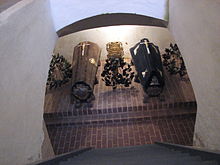Jõgeveste
Coordinates: 58 ° 0 ' N , 26 ° 2' E
Jõgeveste (German Beckhof , later Tepelshof ) is a village ( Estonian küla ) in the Estonian rural community of Tõrva (until 2017 Helme ) in Valga County . It has 185 inhabitants (as of January 1, 2010).
place
Jõgeveste is about 30 km southwest of Otepää ( Odenpäh ). The landscape is characterized by the three lakes Kadajärv , Nauska järv and Rooni järv . Until 1981 there was a Soviet missile base near the place ( map ).
The village of Jõgeveste was first mentioned in 1599 under the name Jeggewicz . Jõgeveste Manor is considerably older and was built before the Livonian War (1558–1583). In the 16th century it belonged to Gerdt von Becke, from whom the German name Beckhof comes. In 1585 it was awarded to Luppert Tepel, whose widow, Gertrud Stackelberg , still owned it in 1599. The name Tepelshof is derived from his family , as the estate was called during the Polish sovereignty over Livonia (1561–1629) and in 1638.
The estate was badly damaged in the Russian-Polish war . It was not re-established until the 18th century. In 1718 Jõgeveste split from the Helme estate.
The last owner before the Estonian land reform after the First World War was Georg von zur Mühlen. The single-storey mansion was destroyed in World War II and is no longer preserved. There are only remnants of the outbuildings.
Michael Andreas Barclay de Tolly
From the end of the 18th century, the estate was owned by the Barclay de Tolly family. The family was actually of Scottish descent and immigrated to the Baltic States in the 17th century . The best-known member of the family was Prince Michael Andreas Barclay de Tolly (1761-1818).
Michael Andreas Barclay de Tolly became famous as a general in the Russian cavalry . He distinguished himself particularly in the Russo-Turkish War (1787–1791) and in the Russo-Swedish War (1788–1790). After the Russian conquest of Finland, he held the post of Tsarist Governor General .
From 1810 to 1812 Barclay de Tolly was Russian Minister of War. During the Russo-French War , he took part in 1812 as a commander in the Battle of Borodino . After the Battle of Leipzig in 1813, he was elevated to the rank of count by the tsar . Barclay de Tolly also commanded the invasion of Napoleonic Paris in March 1814. The Tsar then appointed him field marshal general and gave him the title of prince .
Already ill, Barclay de Tolly withdrew from his military career. He retired on the estate of his wife, the Baltic German Helene Auguste Eleonore von Smitten (1770–1828; married since 1791) in Jõgeveste. Barclay de Tolly died in 1818 near Insterburg on a trip to Bohemia to relax . His embalmed body is buried in the Jõgeveste mausoleum .
The neo-classical mausoleum is located one and a half kilometers from the former estate located on the west bank of the River Väike-Emajõgi ( Little Embach ). It has been a museum since the 1970s.
The mausoleum was built in 1823 on behalf of the widow Barclay de Tollys by the Petersburg architect Apollon Shchedrin in the style of a Roman triumphal arch . The family's coat of arms is placed above the portico , which rests on two columns . The motto in Russian is "Верность и терпение" ("Loyalty and patience").
The interior of the mausoleum made of granite , marble , bronze and porphyry is adorned with a four-meter-high obelisk with a bust of Barclay de Tolly. A statue of Minerva / Athene , the goddess of war, who holds a laurel wreath over the bust, and the sculpture of a seated woman as a symbol of mourning are grouped around the bust . A relief shows Barclay de Tolly's invasion of Paris on March 31, 1814. The interior was designed by the Russian sculptor Wassili Demut-Malinowski (1779–1846). The monument to Barclay de Tolly in downtown Tartu was also made by the same artist .
The sarcophagi of Barclay de Tolly and his wife can be found in the crypt , which is accessible via an opening framed with Empire balusters . The most important stations of his life and the battles are immortalized on boards all around.
A wide sandy path with an avenue of fir trees leads to the mausoleum . The only son, Ernst Magnus Barclay de Tolly (1798–1871), rests next to the mausoleum with his wife Leocadie (1807–1852). Since 1973 there has been a memorial to the Soviet soldiers who died in the conquest of Estonia in 1944 .
literature
- Ivar Sakk: Eesti mõisad. Rice yuht. Tallinn 2002, ISBN 9985-78-574-6 , p. 260.
- Thea Karin: Estonia. Cultural and scenic diversity in a historical borderland between east and west. Cologne 1994, ISBN 3-7701-2614-9 , pp. 259f. (= DuMont art and landscape guide).
Web links
- Description of the place (Estonian)
- Official website of the mausoleum (Estonian)
- Jõgeveste Manor and Mausoleum (Estonian)
Individual evidence
- ↑ http://www.aviastar.org/travel/gallery.php?dir=eesti/jogeveste
- ↑ Indrek Rohtmets: Kultuurilooline Eestimaa . Tallinn 2004 ( ISBN 9985-3-0882-4 ), pp. 306f.



